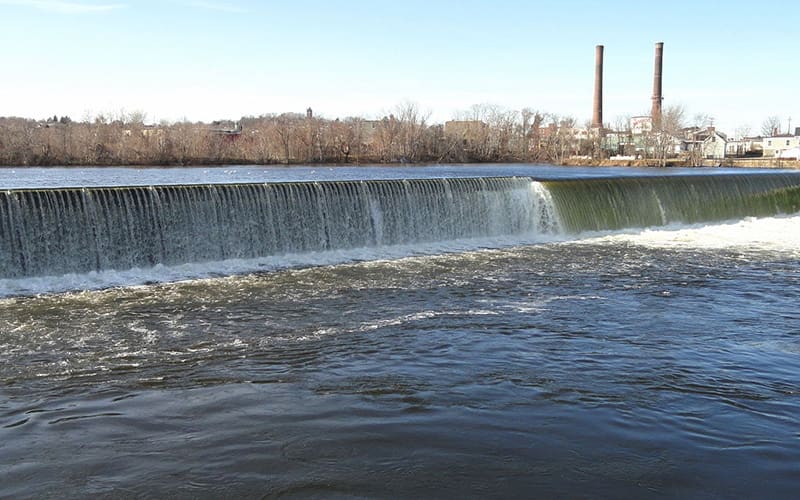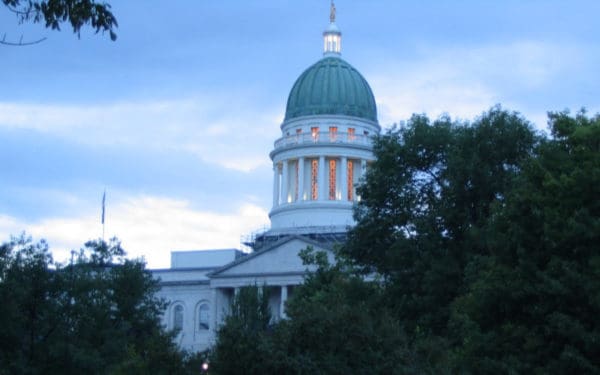
Great Stone Dam in Lawrence, MA
This post is the first in a series on issues surrounding the dilapidated canal infrastructure in Lawrence, Massachusetts. Look for more from Rafael Mares in the coming days. To stay up to date, visit www.clf.org/blog/tag/lawrence-canals-series or follow the hashtag #RestoreLawrenceCanals on Twitter.
In many cities around the world, canals serve as a draw for tourists and locals alike. Whether it is Amsterdam, Ottawa, Providence, Indianapolis, or Albany and Buffalo, historic waterways have turned into huge attractions and drivers of economic success. Not so in Lawrence, Massachusetts, however, where a beautiful mill district is burdened by the city’s dilapidated canals.
Located 25 miles north of Boston on the Merrimack River, Lawrence is considered a gateway city, one of 26 midsize urban areas across the Commonwealth facing social and economic challenges. Like many old mill towns in Massachusetts, Lawrence once prospered, but it has struggled to recover from the gaping economic holes left when its mills and factories shut down mid-century.
Lawrence Is Striving to Rebound
Today, if you hear about Lawrence at all, it tends to only be in the context of crime, fraud, and bad politics. But this image doesn’t square with the way many of its residents and others, like me, see the city. Lawrence is a beautiful, diverse, urban community full of life and culture.
Though Lawrence’s population declined in past decades, it has recently bounced back, and today, more than 70% of its 76,000 residents hail primarily from the Dominican Republic and Puerto Rico. Lawrence is now one of the “youngest” cities in the Commonwealth with 29% of its population under the age of 18. It is also one of the poorest – almost 27% of its residents live below the poverty line.
Led by an energetic mayor dedicated to its resurgence, Lawrence residents, property owners, and community groups are working to revive the city’s struggling economy so that all of its people have the opportunity to thrive. That means ensuring that residents can enjoy all the benefits of city life while not bearing an unfair share of environmental burdens – such as pollution or crumbling infrastructure like the city’s canals.
This is a central tenet of the environmental justice movement and it is at the heart of CLF’s work. We work in close collaboration with local groups and residents in places like Lawrence that are plagued by environmental justice issues to reduce the environmental hazards that threaten our public health and well-being. So when Groundwork Lawrence and Lawrence CommunityWorks approached us about the ongoing issues in their city, it did not take us long to see the need to get involved in the struggle to make Lawrence’s canal infrastructure an environmental asset rather than a burden.
The Canal’s Long History
Lawrence’s two canals were built in the mid-1800s to harness the Merrimack River to power the burgeoning textile mills located along its banks. Located on the north and south banks of the river, the canals directed the water’s flow through gates and locks and over huge turbines that generated power for the textile machinery. The 900-foot Great Stone Dam, built to channel water into the canals, was the largest dam in the world at the time of its construction in the 1840s.
But today, these symbols of Lawrence’s once-prosperous and historic past have become persistent, visible blights. The North Canal in particular, located in an historic district, is overgrown with vegetation. Weeds grow through the crevices of its stones and soil erodes along the banks. The canal walkways are missing railings and its walls are collapsing in many places, making portions unsafe for public access. The water height and flow are also well below the historic levels.
The canal bed is also littered with garbage, despite numerous volunteer cleanups. Anything from car tires to construction debris can be found there. So much trash has accumulated over the years that literally tons of it remain in the canal – at times it’s even been visible on Google Earth satellite pictures. The South Canal, located in a more industrial part of the city, is in equally bad shape.
Potential Lost; Opportunities to be Found
Instead of allowing for recreational opportunities, the deplorable state of Lawrence’s canals squanders them – and with it the prospect for badly needed economic development. To realize its potential as an engine of community economic renewal, the canal infrastructure must be fixed and maintained.
Saving these historic canals from their current neglect will restore them to the people of Lawrence, boost economic opportunity in the surrounding neighborhoods, and honor the unique heritage they represent in a city built on water-powered industry.
In upcoming posts, I will describe why Lawrence finds itself in this situation and how CLF and its partners are working to change the fate of its canals.
Today, CLF and the City of Lawrence filed a complaint to restore the canals of Lawrence to their former glory to help spur the city’s economic development. Read more in our press release.




